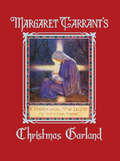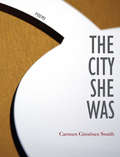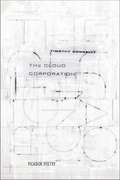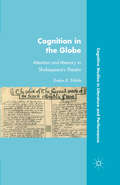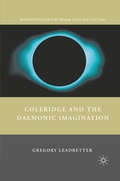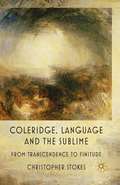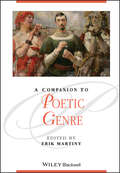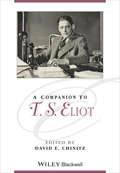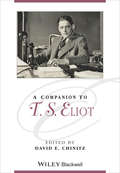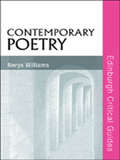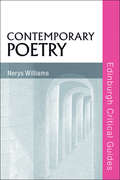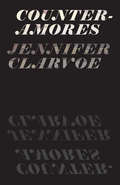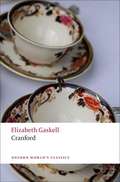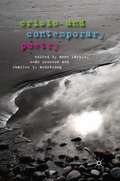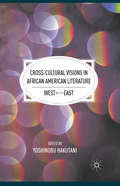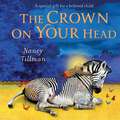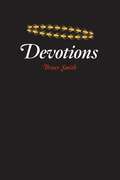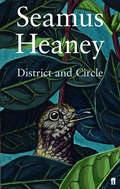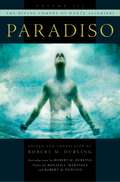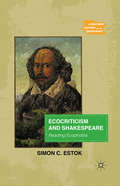- Table View
- List View
A Christmas Garland
by Margaret Tarrant Marian Russell HeathThis enchanting Christmas gift book features stories and poems by St. Luke, William Blake, Alfred Lord Tennyson, William Wordsworth, Hans Christian Andersen, Christina Rossetti, and other literary luminaries. Charming color illustrations complement the brief tales and verses of this holiday treasury — an ideal read-aloud resource for children and families.
The City She Was (Mountain West Poetry Series)
by Carmen Giménez Smith Carmen Giménez SmithMountain West Poetry Series Published by the Center for Literary Publishing at Colorado State University
The Cloud Corporation
by Timothy DonnellyTimothy Donnelly’s brilliant, breakneck and beautiful poetry has been hailed as some of the most original and exciting new work to emerge from the US in several years. In The Cloud Corporation, Donnelly shows how a wholly engaged poetic sensibility can uncover both beauty and meaning within the bewilderments and complexities of contemporary life, without simplifying either its subject or its own investigative approach. In a Donnelly poem, the reader is never sure quite where the next line will take them – the poems pursue their narratives and arguments by surreal association one moment, relentless logic the next – but quickly learns that Donnelly’s is a voice to trust, one which can lead them into astonishing and often unexpected clarities. Writing in the New Yorker, Dan Chiasson said ‘If Whitman had had a young kid and a Brooklyn apartment, too many bills, and a stack of takeout menus in the top drawer of his Ikea desk, he would have written these poems.’ The Cloud Corporation is an imaginative tour de force, and a fine introduction to an essential new poet. 'The best collection I've read in ages: every poem contains something unexpected and unexpectedly powerful. This is serious, modern, ambitious and bold work - the kind of poetry you hope to find, and rarely do' Nick Laird
Cognition in the Globe: Attention and Memory in Shakespeare’s Theatre (Cognitive Studies in Literature and Performance)
by E. TribbleEarly modern playing companies performed up to six different plays a week and mounted new plays frequently. This book seeks to answer a seemingly simple question: how did they do it? Drawing upon work in philosophy and the cognitive sciences, it proposes that the cognitive work of theatre is distributed across body, brain, and world.
Coleridge and the Daemonic Imagination (Nineteenth-Century Major Lives and Letters)
by G. LeadbetterThrough politics, religion and his relationship with Wordsworth, the book builds to a new interpretation of the poems where Coleridge's daemonic imagination produces its myths: The Ancient Mariner, Kubla Khan and Christabel . Re-reading the origins of Romanticism, Leadbetter reveals a Coleridge at once more familiar and more strange.
Coleridge, Language and the Sublime: From Transcendence to Finitude
by C. StokesTraversing the themes of language, terror and representation, this is the first study to engage Coleridge through the sublime, showing him to have a compelling position in an ongoing conversation about finitude. Drawing on close readings of both his poetry and prose, it depicts Coleridge as a thinker of 'the limit' with contemporary force.
The Collected Letters of Robinson Jeffers, with Selected Letters of Una Jeffers: Volume Two, 1931–1939
by Una JeffersThe 1930s marked a turning point for the world. Scientific and technological revolutions, economic and social upheavals, and the outbreak of war changed the course of history. The 1930s also marked a turning point for Robinson Jeffers, both in his career as a poet and in his private life. The letters collected in this second volume of annotated correspondence document Jeffers' rising fame as a poet, his controversial response to the turmoil of his time, his struggles as a writer, the growth and maturation of his twin sons, and the network of friends and acquaintances that surrounded him. The letters also provide an intimate portrait of Jeffers' relationship to his wife Una—including a full account of the 1938 crisis at Mabel Dodge Luhan's home in Taos, New Mexico that nearly destroyed their marriage.
A Companion to Poetic Genre (Blackwell Companions to Literature and Culture #171)
by Erik MartinyA Companion to Poetic Genre brings together over 40 contributions from leading academics to provide critical overviews of poetic genres and their modern adaptations. Covers a large range of poetic cultural traditions from Britain, Ireland, North America, Japan and the Caribbea Summarises many genres from their earliest origins to their most recent renderings The only full-length critical collection to deal with modern adaptations of poetic genres Contributors include Bernard O’Donoghue, Stephen Burt, Jahan Ramazani, and many other notable scholars of poetry and poetics
A Companion to T. S. Eliot (Blackwell Companions to Literature and Culture #168)
by David E. ChinitzReflecting the surge of critical interest in Eliot renewed in recent years, A Companion to T.S. Eliot introduces the 'new' Eliot to readers and educators by examining the full body of his works and career. Leading scholars in the field provide a fresh and fully comprehensive collection of contextual and critical essays on his life and achievement. It compiles the most comprehensive and up-to-date treatment available of Eliot's work and career It explores the powerful forces that shaped Eliot as a writer and thinker, analyzing his body of work and assessing his oeuvre in a variety of contexts: historical, cultural, social, and philosophical It charts the surge in critical interest in T.S. Eliot since the early 1990s It provides an illuminating insight into a poet, writer, and critic who continues to define the literary landscape of the last century
A Companion to T. S. Eliot (Blackwell Companions to Literature and Culture #167)
by David E. ChinitzReflecting the surge of critical interest in Eliot renewed in recent years, A Companion to T.S. Eliot introduces the 'new' Eliot to readers and educators by examining the full body of his works and career. Leading scholars in the field provide a fresh and fully comprehensive collection of contextual and critical essays on his life and achievement. It compiles the most comprehensive and up-to-date treatment available of Eliot's work and career It explores the powerful forces that shaped Eliot as a writer and thinker, analyzing his body of work and assessing his oeuvre in a variety of contexts: historical, cultural, social, and philosophical It charts the surge in critical interest in T.S. Eliot since the early 1990s It provides an illuminating insight into a poet, writer, and critic who continues to define the literary landscape of the last century
Contemporary Poetry (Edinburgh Critical Guides To Literature Ser.)
by Nerys WilliamsDiscussing the work of more than 60 poets from the US, UK, Ireland, Australia, New Zealand and the Caribbean, from Sujata Bhatt to M. Philip NourbeSe and from John Ashbery to Eliot Weinberger, Nerys Williams guides students through the key ideas and movements in the study of poetry today. With reference to original manifestos and web-based experiments, as well as the role of information culture in shaping and distributing poetry globally this book engages with the full vitality of the contemporary poetry scene. Key Features * Wide topic range - from performance to politics, from lyric expression to ecopoetics and from multilingual poetries to electronic writing - enables provocative thematic links to be made * Discussion of global Englishes, dialects and idiolects aimed at those studying poetry on postcolonial literature and contemporary poetics courses * Contemporary relevance: relates poetry to reporting on global conflict, including the impact of the Iraq War * Student resources include a chronology, web resources, a glossary, questions for discussion and a guide to further reading
Contemporary Poetry: The Lyric And Contemporary Poetry (Edinburgh Critical Guides to Literature #1)
by Nerys WilliamsDiscussing the work of more than 60 poets from the US, UK, Ireland, Australia, New Zealand and the Caribbean, Nerys Williams guides students through the key ideas and movements in the study of poetry today.
Contradance (Phoenix Poets)
by John PeckIn a country where much of the prominent poetry seeks to affirm the fleeting present and its changing values, John Peck’s poetry comes as an important, if unlikely, gift. Peck’s verse deals the cards of the fragmentary, ideogramic, juxtapositional, and elliptical through the deck of normally discursive syntax. Echoing late high Modernism, Peck’s work, in the words of novelist Joseph McElroy, is “a way of seeing things,” confident “in the packed vividness of the referential.” Avoiding the narrow identity- or group-specific viewpoint of some of his contemporaries, Peck invites us to enter the larger humanscape and unearth with him unnoticed connections to our shared past and to one another. In Contradance, his ninth collection, Peck’s passion for inquiry and historical reflection has never been stronger or more beautifully embodied.
Contradance (Phoenix Poets)
by John PeckIn a country where much of the prominent poetry seeks to affirm the fleeting present and its changing values, John Peck’s poetry comes as an important, if unlikely, gift. Peck’s verse deals the cards of the fragmentary, ideogramic, juxtapositional, and elliptical through the deck of normally discursive syntax. Echoing late high Modernism, Peck’s work, in the words of novelist Joseph McElroy, is “a way of seeing things,” confident “in the packed vividness of the referential.” Avoiding the narrow identity- or group-specific viewpoint of some of his contemporaries, Peck invites us to enter the larger humanscape and unearth with him unnoticed connections to our shared past and to one another. In Contradance, his ninth collection, Peck’s passion for inquiry and historical reflection has never been stronger or more beautifully embodied.
Counter-Amores (Phoenix Poets)
by Jennifer ClarvoeJennifer Clarvoe’s second book, Counter-Amores, wrestles with and against love. The poems in the title series talk back to Ovid’s Amores, and, in talking back, take charge, take delight, and take revenge. They suggest that we discover what we love by fighting, by bringing our angry, hungry, imperfect selves into the battle. Like a man who shouts for the echo back from a cliff, or the scientist who teaches her parrot to say, “I love you,” or the philosopher who wonders what it is like to be a bat, or Temple Grandin’s lucid imaginings of the last moments of cattle destined for slaughter, the speakers in these poems seek to find themselves in relation to an ever-widening circle of unknowable others. Yearning for “the sweet cool hum of fridge and fluorescent that sang ‘home,’” we’re as likely to find “fifty-seven clicks and flickering channels pitched to the galaxy.” Song itself becomes a site for gorgeous struggle, just as bella means both “beautiful” and “wars.”
Counter-Amores (Phoenix Poets)
by Jennifer ClarvoeJennifer Clarvoe’s second book, Counter-Amores, wrestles with and against love. The poems in the title series talk back to Ovid’s Amores, and, in talking back, take charge, take delight, and take revenge. They suggest that we discover what we love by fighting, by bringing our angry, hungry, imperfect selves into the battle. Like a man who shouts for the echo back from a cliff, or the scientist who teaches her parrot to say, “I love you,” or the philosopher who wonders what it is like to be a bat, or Temple Grandin’s lucid imaginings of the last moments of cattle destined for slaughter, the speakers in these poems seek to find themselves in relation to an ever-widening circle of unknowable others. Yearning for “the sweet cool hum of fridge and fluorescent that sang ‘home,’” we’re as likely to find “fifty-seven clicks and flickering channels pitched to the galaxy.” Song itself becomes a site for gorgeous struggle, just as bella means both “beautiful” and “wars.”
Cranford
by Elizabeth Cleghorn GaskellA portrait of the residents of an English country town in the mid nineteenth century, Cranford relates the adventures of Miss Matty and Miss Deborah, two middle-aged spinster sisters striving to live with dignity in reduced circumstances. Through a series of vignettes, Elizabeth Gaskell portrays a community governed by old-fashioned habits and dominated by friendships between women. Her wry account of rural life is undercut, however, by tragedy in its depiction of such troubling events as Matty's bankruptcy, the violent death of Captain Brown or the unwitting cruelty of Peter Jenkyns. Written with acute observation, Cranford is by turns affectionate, moving and darkly satirical.
Crisis and Contemporary Poetry
by Anne Karhio, Seán Crosson and Charles I. ArmstrongWhat are the means available to poetry to address crisis and how can both poets and critics meet the conflicts and challenges they face? This collection of essays addresses poetic and critical responses to the various crises encountered by contemporary writers and our society, from the Holocaust to the ecological crisis.
Cross-Cultural Visions in African American Literature: West Meets East
by Yoshinobu HakutaniThe most influential East-West artistic, cultural, and literary exchange that has taken place in modern and postmodern times was the reading and writing of haiku. Here, esteemed contributors investigate the impact of Eastern philosophy and religion on African American writers such as Richard Wright, Ralph Ellison, and Toni Morrison, offering a fresh field of literary inquiry.
The Crown on Your Head: A special gift for a beloved child
by Nancy TillmanWe know our children are special, and now, author and illustrator Nancy Tillman expresses this universal feeling in the most touching of ways: Every child is born with a crown. The crown is everything that gives us unique value. Our crown will always be with us wherever we go, whatever we do.The Crown on Your Head is a perfect gift for baby showers, graduation, and for any other occasion to tell dear ones that they are loved.
Devotions (Phoenix Poets)
by Bruce SmithIn the hands of Bruce Smith, devotions are momentary stops to listen to the motor of history. They are meditations and provocations. They are messages received from the chatter of the street and from transmissions as distant as Memphis and al-Mansur. Bulletins and interruptions come from brutal elsewheres and from the interior where music puts electrodes on the body to take an EKG. These poems visit high schools, laundromats, motels, films, and dreams in order to measure the American hunger and thirst. They are interested in the things we profess to hold most dear as well as what’s unspoken and unbidden. While we’re driving, while riding a bus, while receiving a call, while passing through an X-ray machine, the personal is intersected—sometimes violently, sometimes tenderly—with the hum and buzz of the culture. The culture, whether New York or Tuscaloosa, Seattle or Philadelphia, past or present, carries the burden of race and “someone’s idea of beauty.” The poems fluctuate between the two poles of “lullaby and homicide” before taking a vow to remain on earth, to look right and left, to wait and to witness.
Devotions (Phoenix Poets)
by Bruce SmithIn the hands of Bruce Smith, devotions are momentary stops to listen to the motor of history. They are meditations and provocations. They are messages received from the chatter of the street and from transmissions as distant as Memphis and al-Mansur. Bulletins and interruptions come from brutal elsewheres and from the interior where music puts electrodes on the body to take an EKG. These poems visit high schools, laundromats, motels, films, and dreams in order to measure the American hunger and thirst. They are interested in the things we profess to hold most dear as well as what’s unspoken and unbidden. While we’re driving, while riding a bus, while receiving a call, while passing through an X-ray machine, the personal is intersected—sometimes violently, sometimes tenderly—with the hum and buzz of the culture. The culture, whether New York or Tuscaloosa, Seattle or Philadelphia, past or present, carries the burden of race and “someone’s idea of beauty.” The poems fluctuate between the two poles of “lullaby and homicide” before taking a vow to remain on earth, to look right and left, to wait and to witness.
District and Circle: Poems (Faber Poetry Ser.)
by Seamus HeaneySeamus Heaney's new collection starts 'in an age of bare hands and cast iron' and ends 'as the automatic lock / clunks shut' in the eerie new conditions of a menaced twentieth-first century. In their haunted, almost visionary clarity, the poems assay the weight and worth of what has been held in the hand and in the memory. Images out of a childhood spent safe from the horrors of World War II - railway sleepers, a sledgehammer, the 'heavyweight silence' of cattle out in rain - are coloured by a strongly contemporary sense that 'anything can happen' and other images from the dangerous present - a journey on the underground, a melting glacier - are fraught with this same anxiety. But District and Circle, which includes a number of prose poems and translations, offers resistance as the poet gathers his staying powers and stands his ground in the hiding places of love and excited language. In a sequence like 'The Tollund Man in Springtime' and in several poems which 'do the rounds of the district' - its known roads and rivers and trees, its familiar and unfamiliar ghosts - the gravity of memorial is transformed into the grace of recollection. With more relish and conviction than ever, Seamus Heaney maintains his trust in the obduracy of workaday realities and the mystery of everyday renewals.
The Divine Comedy of Dante Alighieri: Volume 3: Paradiso
by Robert M. DurlingRobert Durling's spirited new prose translation of the Paradiso completes his masterful rendering of the Divine Comedy. Durling's earlier translations of the Inferno and the Purgatorio garnered high praise, and with this superb version of the Paradiso readers can now traverse the entirety of Dante's epic poem of spiritual ascent with the guidance of one of the greatest living Italian-to-English translators. Reunited with his beloved Beatrice in the Purgatorio, in the Paradiso the poet-narrator journeys with her through the heavenly spheres and comes to know "the state of blessed souls after death." As with the previous volumes, the original Italian and its English translation appear on facing pages. Readers will be drawn to Durling's precise and vivid prose, which captures Dante's extraordinary range of expression--from the high style of divine revelation to colloquial speech, lyrical interludes, and scornful diatribes against corrupt clergy. This edition boasts several unique features. Durling's introduction explores the chief interpretive issues surrounding the Paradiso, including the nature of its allegories, the status in the poem of Dante's human body, and his relation to the mystical tradition. The notes at the end of each canto provide detailed commentary on historical, theological, and literary allusions, and unravel the obscurity and difficulties of Dante's ambitious style . An unusual feature is the inclusion of the text, translation, and commentary on one of Dante's chief models, the famous cosmological poem by Boethius that ends the third book of his Consolation of Philosophy. A substantial section of Additional Notes discusses myths, symbols, and themes that figure in all three cantiche of Dante's masterpiece. Finally, the volume includes a set of indexes that is unique in American editions, including Proper Names Discussed in the Notes (with thorough subheadings concerning related themes), Passages Cited in the Notes, and Words Discussed in the Notes, as well as an Index of Proper Names in the text and translation. Like the previous volumes, this final volume includes a rich series of illustrations by Robert Turner.
Ecocriticism and Shakespeare: Reading Ecophobia (Literatures, Cultures, and the Environment)
by Simon C. EstokThis book offers the term 'ecophobia' as a way of understanding and organizing representations of contempt for the natural world. Estok argues that this vocabulary is both necessary to the developing area of ecocritical studies and for our understandings of the representations of 'Nature' in Shakespeare.
